9.1 Basic Elements of Art
BASIC ELEMENTS OF ART
EXPRESSIVE CONTENT:
The expressive content of a work of art is its total emotional and intellectual effect based on the relationship of the five following aspects of analysis to one another.
-
- Subject matter
- Organization of basic elements
- Historical events and concerns
- Associated values
- Viewer’s reaction
SUBJECT MATTER:
This is also called Iconography. A statue of a young nude male will have a different meaning in different cultures, for example, Apollo in Classical Greece, David in the Renaissance. Subject matter also includes the symbolic meaning of the subject; for example, David was not merely the ancient king of Israel in Renaissance art, but was also a symbol of political freedom against tyranny.
BASIC ELEMENTS:
The basic elements that an artist employs to create a work of art include color, light and shadow, line, texture of the medium, space and perspective and shape. The relationships of those elements to one another and to the work of art as a whole determine the formal organization of that work. The Basic Elements include:
-
- Color
- Light and shadow
- Line
- Shape and form
- Medium
- Texture
- Space
1. COLOR
Paintings may be monochromatic or polychromatic. A painting is termed monochromatic when colors derive from one primary color. A polychromatic painting includes several contrasting colors. In paintings, color can define form and organize space. It can direct the eye from one place to another by shifting the emphasis from one color mass to another. It can add to the sense of motion by expanding and contracting space, when dark colors are used to suggest contraction and light colors expansion. Chiaroscuro is the graduation of lights and darks to create three-dimensional forms.

Monochromatic, polychromatic and chiaroscuro techniques may be observed in Jan Van Eyck’s Ghent Altarpiece. The front, or cover, is painted in monochrome colors to resemble Gothic statues. When the cover is opened, we can see the bright polychromatic colors of the inside of the polyptych. The chiaroscuro shading of light and dark values is easily observed on the robes of the figures.
2. LIGHT and SHADOW
Light and shadow can create volume or three- dimensional forms and space. They can also create a sense of movement and often suggest naturalism or dramatic realism.
3. LINE
A line is an identifiable path created by a point moving in space. It is one-dimensional and can vary in width, direction, and length. Lines often define the edges of a form. Lines can be vertical, horizontal, diagonal, curved and straight. Lines may vary in thickness, clarity, smoothness, and direction. They lead your eye around the composition and can communicate information through their character and direction
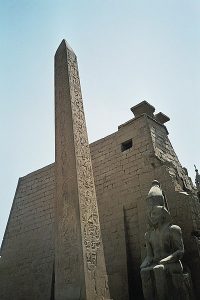
Vertical lines are perpendicular to the earth; they suggest strength and draw the eye upward. In the Obelisk of Rameses II at Luxor in Thebes vertical lines suggest spirituality, rising beyond human reach toward the heavens.
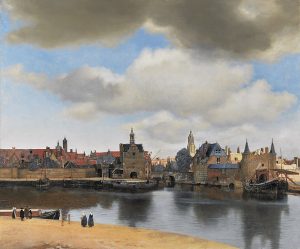
Horizontal lines suggest a feeling of rest or repose because objects parallel to the earth are at rest. In A View of Delft, by Vermeer horizontal lines also imply a continuation of the landscape beyond the picture plane to the left and right.
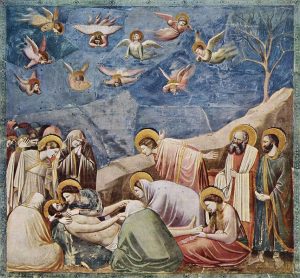
Because diagonal objects are neither vertical nor horizontal, they are either about to fall or are already in motion; therefore, diagonal lines often suggest dynamism or movement. The rock cliff in Giotto’s Pietà serves to move the viewer’s eye toward the figure of Christ at the base of the cliff.
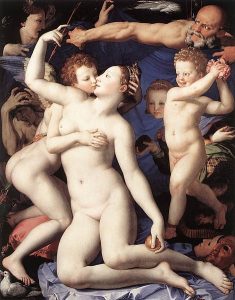
Soft, shallow curves recall the curves of the human body and often have a pleasing, sensual quality and a softening effect. Confusion may be created by a mixture of various types of line and direction. Bronzino’s Allegory of Venus includes both sensuous body curves as well as the inconsistency of a mixture of lines.
4. SHAPE and FORM
Define objects in space. Shapes have two dimensions—height and width—and are usually defined by lines. Forms exist in three dimensions: height, width, and depth. The shape of an object may be defined by color, line, texture, or medium.
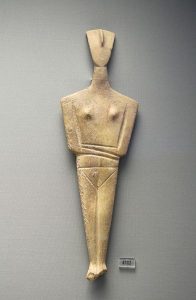
Artists seeking perfection often build their designs on various geometric shapes — triangle, pyramid, circle, cylinder – on mathematical proportions. We see an example of this in the Cycladic Bronze age sculpture from Athens.
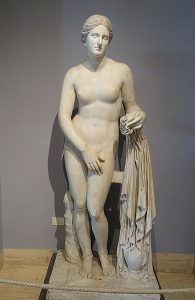
Artists influenced by naturalism, humanism, or individualism usually base their designs on natural (organic) forms such as the human weight-shift pose or contrapposto. Praxitiles’ Aphrodite of Knidos demonstrates both an organic form as well as the contrapposto position.
5. MEDIUM
All works of visual art are made of some material — metal, marble, glass, fiber, and wood, oil or water based paints applied to paper, canvas, or wood.
6. TEXTURE
Is the surface quality of an object that we sense through touch. All objects have a physical texture. In a two-dimensional work of art, texture gives a visual sense of how an object depicted would feel in real life if touched: hard, soft, rough, smooth, hairy, leathery, sharp, etc. In three-dimensional works, artists use actual texture to add a tactile quality to the work. The texture of a work of art is either inherent in the medium or developed from it by the artist’s technique. In painting, brushstrokes, either blended or painterly, affect texture.
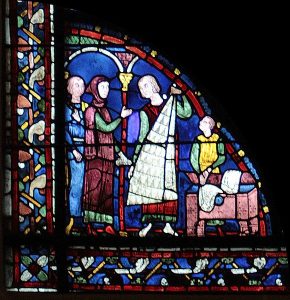
Ambulatory, Chartres Cathedral, a stained glass window showing the texture contrast of the fur and other clothing.
7. SPACE
Real space is three-dimensional. Space in a work of art refers to a feeling of depth or three dimensions. The perfect illusion of three-dimensional space in a two-dimensional work of art is something that many artists labored to achieve.
Several techniques may be used to achieve a feeling of three-dimensional space. These include
- Overlapping
- Foreshortening of isolated objects
- Chiaroscuro (displaying a “sculptural” form through the use of light and dark)
- Relative position from ground line
- Background
Linear Perspective (transforming entire picture into a “window”). All objects are represented as seen from a single point of view called the vanishing point at which all orthogonals (lines perpendicular to the picture plane) seem to converge. Associated objects diminish in size as their distance from the observer increases.
- Intuitive Perspective
- Aerial or Atmospheric Perspective (the apparent change in color and distinctness of objects as they recede from the picture plane; objects in the foreground are painted in detail and with relatively clear, bright colors; objects in the background are rendered in less detail and in grayed colors).
Space can also refer to the artist’s use of the area within the picture plane. The area around the primary objects in a work of art is known as negative space, while the space occupied by the primary objects is known as positive space. The relationship of positive to negative space can greatly affect the impact of a work of art.
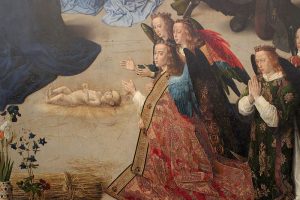
In the Portinari Altarpiece, the Christ child occupies the positive space, while the space surrounding him is the negative space. The disproportionate amount of negative space around the Christ child accentuates the figure’s vulnerability.
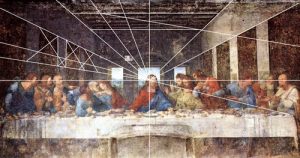
The perfect illusion of three-dimensional space in a two-dimensional work of art is something that many artists, such as Leonardo da Vinci in his painting the Last Supper labored to achieve. This work is a good example of linear perspective. Space, in a work of art, is the most difficult element to analyze because it may be defined by any or all of the other elements of visual art. During most historical eras, a typical approach to spatial form emerges. Space may be defined as open or closed depending upon the physical and psychological aspect of the work of art.
|
Closed |
Open |
|
Verticals and horizontals dominate |
Verticals and horizontals obscured |
|
Clearly felt central axis |
Central axis absent |
|
Frame seems to contain |
Spills out over frame |
|
Posed, deliberately placed in frame |
As if cut out of the visible world |
|
Stable and balanced |
Unstable equilibrium |
|
Frontal plane dominates |
Subjects at angles to frontal plane |
|
Dense |
Penetrated by space |
|
Static |
Dynamic |
|
IDEALISM |
REALISM |
SPACE in SCULPTURE and ARCHITECTURE
Sculpture and architecture relate to space in similar ways, although in architecture both the interior and exterior must be considered.

Closed Form is based on solid masses of material largely reflecting the block(s) from which the work of art is carved or constructed. The composition is formed to some extent by geometric shapes and/or compact masses in static balance. Closed art, such as the Pyramid of Khafre at Giza, emphasizes repose or relaxation, harmony and completion. Statues lacking weight-shift are already in repose and should, thus, be termed closed. Many of Michelangelo’s statues are designed, almost as a tightly coiled spring, to illustrate tension and pent-up energy. While the potential for movement is present, since the body is wound into a compact mass, tension and emotion are contained; the form is, therefore, considered closed.
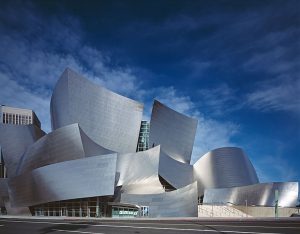
Open forms are incomplete, projecting into space or penetrating the environment. Their focus is usually external. A figure or a building, such as the Walt Disney Opera House in Los Angeles, Califorina, which acts on its surroundings or interacts with its environment, is generally considered open. Statues are considered open because they are about to release tension and have yet to return to a relaxed position.
SPACE in PAINTING:
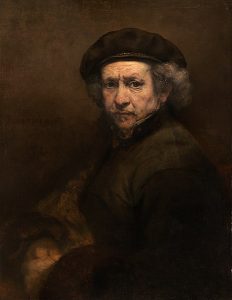
Paintings that have an obvious frame and a central focus and emphasize repose, certainties and finalities are considered closed. Rembrandt’s Self-Portrait of 1659 is an example of a closed work.

Paintings that seem to spill over the edges in any direction, lack clear boundaries, have multiple focal points and emphasize action, emotion, uncertainty and incompleteness are termed open. In Rembrandt’s Sortie of Captain Banning Cocq’s Company of the Civic Guard, diagonal and curved lines direct the viewer from place to place inside and outside of open paintings. In painting, space is an illusion of three-dimensionality which has been created by the recession of an object into the distance or by the projection forward of an object. In contrast, space may be denied by placing figures or objects on a flat plane. Space can be constructed in numerous ways: by receding planes, by overlapping of figures or objects, by light and shadow, by foreshortening (extending an object at an angle to suggest decrease in size). In some paintings the space is contrived from a fixed point of view unifying the parts of a painting; others suggest space by shifting the viewer’s attention from one area to the next with lines, color, and/or light.
HISTORICAL CLIMATE
A work of art is the product of the past and the present of the culture in which it was created. Products of culture can, therefore, only be studied within a historical context. Not all aspects of history, however, influence every work of art. It is, therefore, necessary, after the history of an era has been studied, to select the known historical trends or facts which probably influenced a particular artifact (primary source). Analysis or interpretation of primary sources in the arts is not a science. It does, however, teach the skills of critical thinking because it allows the interpreter to make connections, to make choices based on facts and patterns and to use her or his eye.
1. What was the geographical location of the culture? Did it have regular contact with other, different cultures? Did the geography affect the economic base of the culture?
2. What was the basis for the culture’s economy? Was the country wealthy or poor? Why?
3. What was its political system? Was it hierarchical or democratic? Was there a revolution? What was its effect?
4. What religions were followed? Which were the most popular and why? Were religious monuments built and in whose honor? How was information about this religion conveyed to the people?
5. What were the major scientific developments during this time? In what ways did they impact the culture?
6. What were the moral and ethical standards of the time? Did most people adhere to them? How did they impact the culture? Was the art of the period based on a philosophical concept?
7. What arts were popular in this culture? Why was one art more popular than others?
8. What styles or forms from the preceding period were strong enough to influence the following era?
9. What is the function of the art in question? For whom was it created? Who commissioned and paid for it?
10. Who was responsible for the design of the art? If the artist had autonomy, what was his background and experience? Who were the patrons?
ASSOCIATED VALUES
Cultural values, which are influenced by the historical climate, are reflected in the arts of a culture. They can be defined as:
1. Those things which are valued and revered by a socio-economic group
2. Ideas that underlie a culture
3. Attitudes about the world and humanity characteristic of a particular group or milieu.
VIEWER’S REACTION
Art is supposed to wake you up, taking us where we haven’t been before. When we add our ideas to those of the creative thinker from another era, we are lead to dazzling new possibilities and experiences as well as new ways of looking at the world.
Art leads the observer to contemplate life by looking through the eyes of another.

